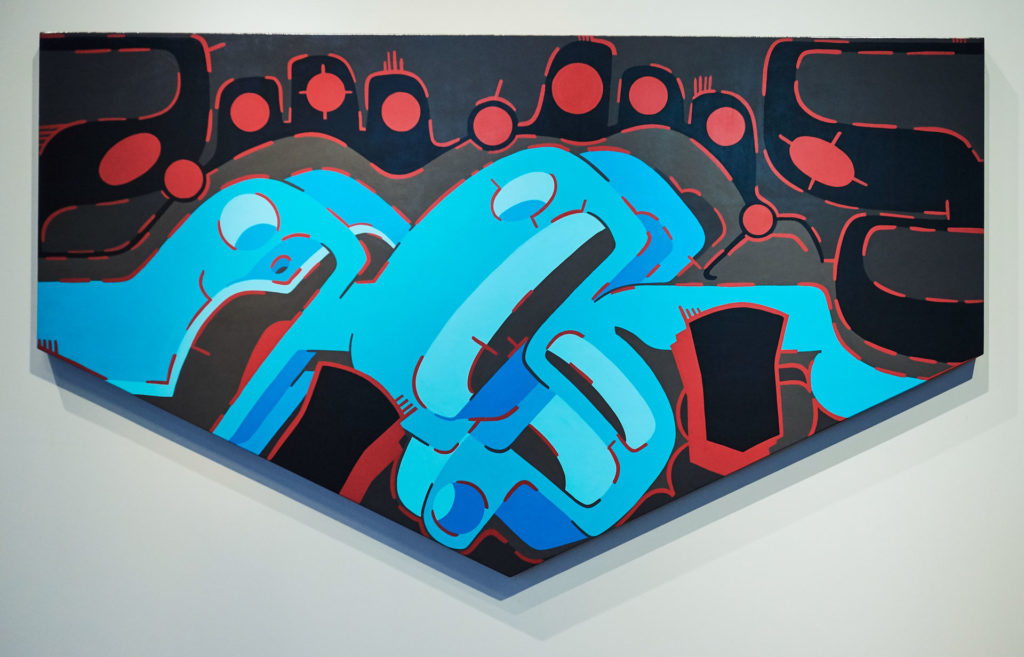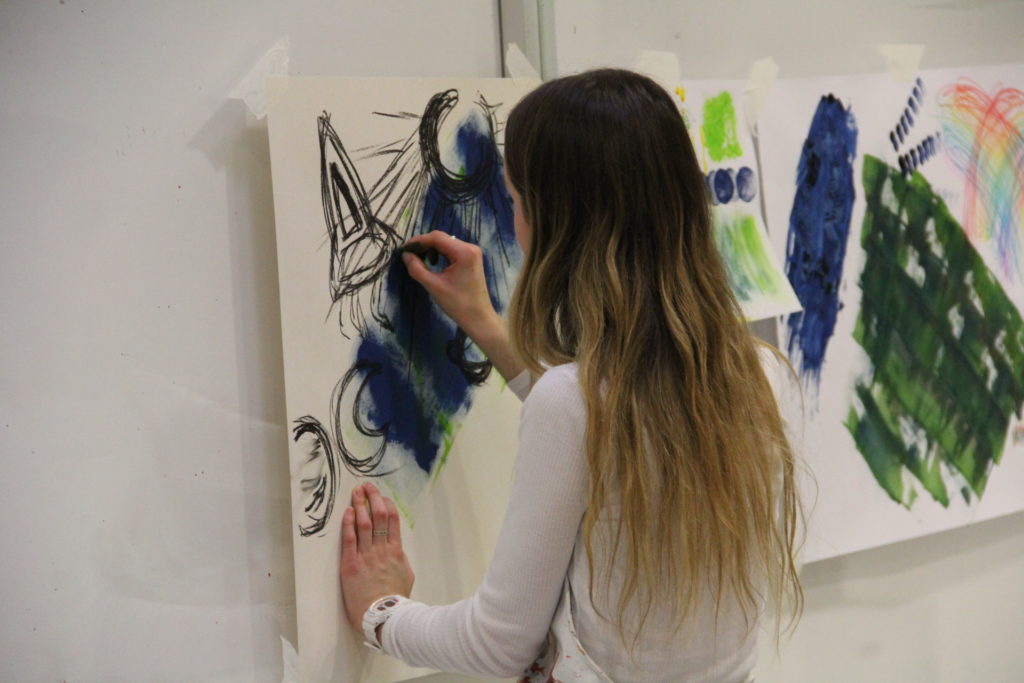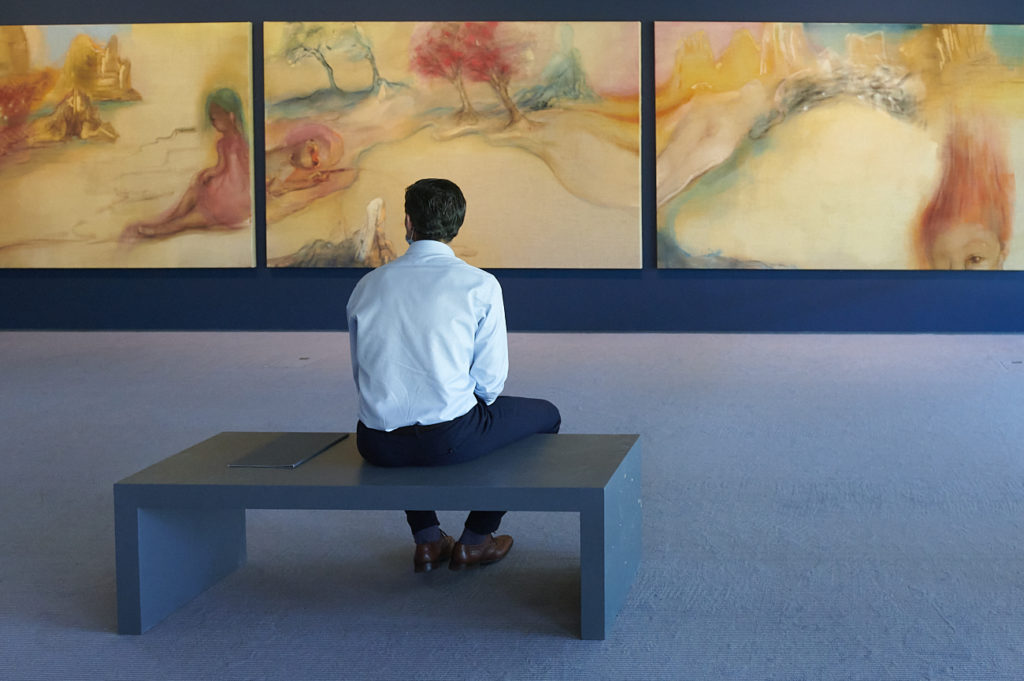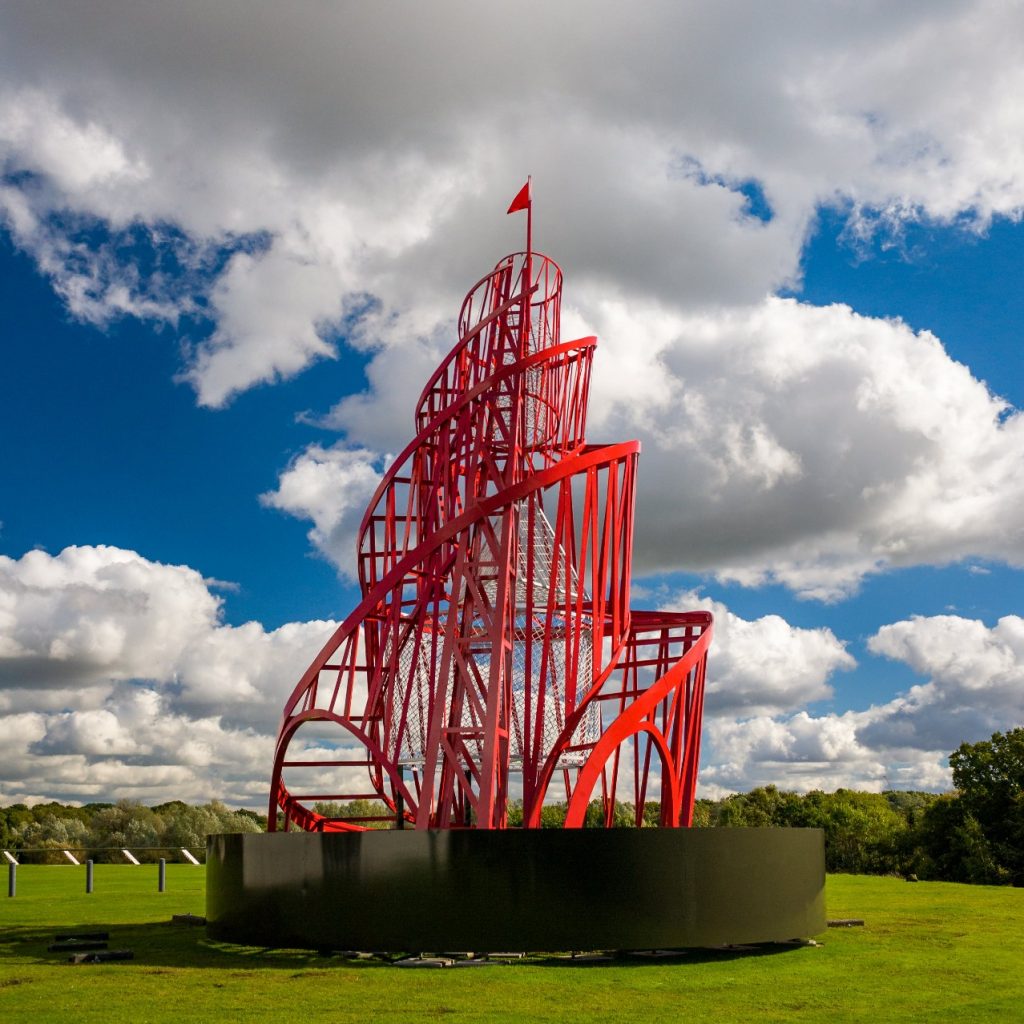The Pacific Northwest Coast stretches along the coast from Northern Washington (USA), into Vancouver in present day Canada, and to Alaska in the north. The art of this region is widely acknowledged as one of the great artistic legacies from any period and any place. The coastal region consists of a diverse group of Indigenous nations and is very much a living tradition. Indigenous artists pursue a range of art practices which relate to historic artistic inheritance as well as the contemporary situation. Their art expresses the right to exist despite the many injustices and persecutions during the colonial period and its legacy. An expression of cultural freedom through resistance and activism. The artist Sonny Assu, Ligwiłda’xw of the Kwakwaka’wakw nations, completed a residency at the Sainsbury Centre in 2019. His presence gave voice to the ancestors who made remarkable historical artworks. Assu made us think about the presence of these works in European museums, and what agency they are offered. The residency resulted in the Centre acquiring a painting by Assu, the Centre’s first by a contemporary indigenous artist from the region
The Art of the Pacific Northwest Coast at the Sainsbury Centre
Head of Collections, Calvin Winner, explores the art of the Pacific Northwest Coast at the Sainsbury Centre.

Raven rattle, musical instrument, Haida, Tlingit, leather, paint, stone, wood, Purchased with support from Robert and Lisa Sainsbury, 1982

Sonny Assu, Dance As Though the Ancestors Are Watching, 2019, painting © Courtesy of the Artist
To appreciate artistic practices of the Pacific Northwest Coast, it is vital to understand this is a culture embedded in the natural environment, rather than a separate entity. The many islands, inlets, mountainous fjords and temperate rainforests of Red Cedar, Yellow Cedar, Redwood and Douglas Fir. The Cedar or ‘Tree of Life’ is a key natural resource integral to life. Used for building long houses, carving of ancestor poles and sea-faring canoes; the carving of ceremonial rattles, masks, head-dress frontlets and ladles, and the weaving of ceremonial robes and basketry. Even the natural resources of the ocean rely on Cedar for curing and cooking fish over the open fire. This rich ocean and coastal forest ecosystem supported a culture and way of life until the colonial period. Sustainable historic trade and harvesting practices were displaced, as industrialization meant the rich resources of the region were over exploited. The great ancient forests were ravaged by logging. The culturally important salmon, beaver pelts and the taking of whales on an industrial scale devastated the region. The disregard for the balance of nature is at the heart of current Indigenous discord. Land rights remain central to Indigenous grievance and activism, but not land simply as simply as property rather as culture, social systems and spirituality.

Lighthouse Park, West Vancouver
The art and artists of the region are as varied as their distinct cultures. At the Sainsbury Centre there are works from Tlingit, Tsimshian, Haida, Heiltsuk, Nuu-chah-nulth, Makah and now Kwakwaka’wakw. There is a shared form of visual communication based on hereditary symbolism and storytelling, including creation mythologies, an expression of the symbiotic relationship with the environment and the harmonious relationship between humans and animals. Ravens, bears, beavers, wolves, eagles, whales, salmon, and supernatural creatures are integral to their way of life and integral to the art and ancestry of the peoples. A complex and stylized artform whose primary traditional function is the display of crests that encode family lineages, celebrate clan histories or memorialize great leaders within heraldic family crests. They express the way people relate to the world and conceive of their past, present and future. Northwest Coast art incorporates the use of characteristic shapes such as ovoid’s, ‘U’ forms and ‘S’ forms, which has come to be known as ‘formline’. The unique formline matrix is found throughout the art of the region and provides a visual framework of great complexity for multiple layers of storytelling.
The Sainsbury Centre collection includes thirty-six remarkable historical artworks that originate from the Pacific Northwest Coast. I have chosen four examples to explore in detail: the Haida head-dress frontal; a Tlingit comb collected from the Vancouver voyages; a Haida Chief’s Rattle, and a spectacular Tlingit Chilkat robe. Many of these were regalia made to celebrate the great ceremonial tradition of the Northwest Coast known as the Potlatch. The Potlatch ceremony is held to celebrate or commemorate significant events such as marriages, births and deaths; to resolve disputes between rival families or negotiate management of natural resources, and to reaffirm a leader’s power and status. There is no greater expression of culture than a chief relinquishing valuable items or destroying his wealth. The distribution of assets and chattels was a primary means by which a leader’s greatness could be measured. Indeed, the poorer the leader became in material goods, the greater chance they could ascend to higher esteem. This celebration of culture involves feasting and ceremonial songs, dances and masked dancing. Singing, drumming and dances conveyed history through storytelling. The making of speeches conveyed specific ceremonies, passed laws, corrected injustices, welcomed new life or family members, or honored those who had passed. Humour was also omnipresent during these celebrations, often with pranks, tricks, jokes, and games. The Potlatch, integral to the Indigenous way of life, came to the attention of the colonial authorities who issued a ban in 1884. The material and ceremonial culture associated with the Potlatch was effectively outlawed and deemed illegal. Items were confiscated by the authorities, known as Indian Agents (officers of the Canadian government, under the Indian Act) and sold to collectors, anthropologists and museums around the world. This in turn led to the objects’ contested relocation to European museums. The ban itself was a painful tool of assimilation used by the colonial authorities and seen by Indigenous nations as part of a wider genocide. The ban ended in 1951, but the damage suffered by the Indigenous peoples can still be seen today. The process was accelerated and exacerbated by Christian missionaries, resulting in the loss of language and culture. Today these historical artworks in museums are a physical link to ancestors for indigenous people today. The tradition of the Potlatch, despite the sixty-seven-year ban, maintained relevance for the peoples. In an act of defiance, Chiefs from various nations moved the ceremonies underground or realigned them with colonial or Christian celebrations to maintain a connection to the important ceremony. Even while banned, the Potlatch remained at the center of Indigenous life, which is relevant to the celebrations today, as new generations of Indigenous artists, knowledge keepers and ceremonial practitioners can still maintain and reference the importance of the ceremony.
This ceremonial head-dress frontlet (590), worn by chiefs at Potlatches, dates to the 19th century. It is made from Cedar wood inlaid with abalone shell and its iconography displays heraldic family crests. In this example, the bear as the owner would have had the right to display the bear crest. The most eminent chiefs had the right to display many crests. The head-dress found itself in colonial freefall until the famous New York antiquities dealer, James Economos, (1938-2008) sold it to Robert and Lisa Sainsbury in 1974. They acquired it for the Sainsbury Centre, in time for its opening in 1978 at the University of East Anglia. Before that, it appeared in the exhibition, Sacred Circles (Cat.298) at the Hayward Gallery from Oct 1976 to Jan 1977. According to Economos, it had once belonged to Son-i-hat (Kóyongxung), a famous Haida chief of Yáadaas clan (Eagle moiety), of the Kaigani Haida at Kasaan (Kasa’aan), Prince of Wales Island (xʼaaxʼ aani) in modern day Alaska. Son-i-hat was born in 1829 and lived a remarkable life until 1912.

Head-dress frontlet, Kaigani, Haida, abalone shell , paint, sinew, wood, 19th Century. Purchased with support from Robert and Lisa Sainsbury, 1974
The Ceremonial robes and regalia worn by the hosts of the Potlatch are some of the greatest expressions of Northwest Coast art and culture. The Kwakwaka’wakw, for example, had richly decorated robes, known as button blankets, and adorned with abalone shell buttons and displayed the wearer’s crest or clan symbol.
The wonderful historic Tlingit Chilkat robe (667) originating from the Chilkat of the Tlingit peoples and made in the late-19th century. The yarns are from a combination of Yellow Cedar bark and mountain goat wool and dyed with plant extracts. Traditionally both men and woman were involved in the designs, while the weaving was typically undertaken only by woman. The intricate design and symbolism of the wearer’s environment is conveyed through the symbolism of mountains and water, and also includes the crest animals relating to ancestry of the individual. In this case, the imagery relates to cultural stories involving the diving whale and the raven.
Ceremonial robes remain important symbols of status in First Nations society. They are worn and danced in at Potlatches, hung on grave houses containing the bones of deceased chiefs, laid on dead bodies during ceremonies and used to decorate the walls of clan houses. This example ended up under the ownership of the former Governor of Alaska, B. Frank Heintzleman, although it remains unclear how he obtained it. It later appeared at auction and was purchased by John Hewett, a London-based antiquities dealer. He sold it to Robert and Lisa Sainsbury and the University in 1976. Klukwan is the only remaining of five Chilkat villages that were in the area before 1900.

‘Chilkat’ Robe, Chilkat, Tlingit, mountain-goat wool, yellow cedar bark, late 19th Century. Purchased with support from Robert and Lisa Sainsbury, 1976
The Haida, Tlingit ceremonial chief’s rattle (831) dates back to the mid-19th century. The most common historical use of raven rattles was to provide rhythm for songs, dances, and chants, and/or signaling the spiritual presence of the ancestors. Carried by a chief, it was part of their ceremonial regalia that they would typically wear at a Potlatch, along with the frontlet headdress and robe.
The rattle was also a very important piece of shamanic equipment throughout the Northwest Coast. The iconography of the raven in this case suggests a Chief’s rattle. The bird form in fact has three faces: the raven, with a hawk carved on its breast and a reclining figure on its back, with a wolf’s head. This figure has its tongue conjoined with that of another creature. In the mouth of the raven is a box containing the sun and hence the light of the world. Formerly in the collection of James Hooper, it was purchased by the Sainsbury Centre, from Christie’s on the advice of Robert Sainsbury in 1982.

Raven rattle, musical instrument, Haida, Tlingit, leather, paint, stone, wood, Purchased with support from Robert and Lisa Sainsbury, 1982
The beautiful decorative comb, (875) dates to the late-18th century. Made by the Tlingit from Caribou antler, traded from the interior. Three of its thirteen teeth are missing but the decoration is outstanding. It depicts the raven who, in Northwest Coast mythology, appears in many stories as the trickster, capable of transforming into many guises. The iconography is arranged in the formline matrix and provides a visual framework of great complexity.
With thanks to Sonny Assu (Ligwiłda’xw of the Kwakwaka’wakw Nations).
You might be interested in

Learn & Create
The artworks in our collection and exhibitions come to life when you join us to look, think, discuss, question, create, play and tell stories around them. Find out how you can get involved and become a part of our learning community.

